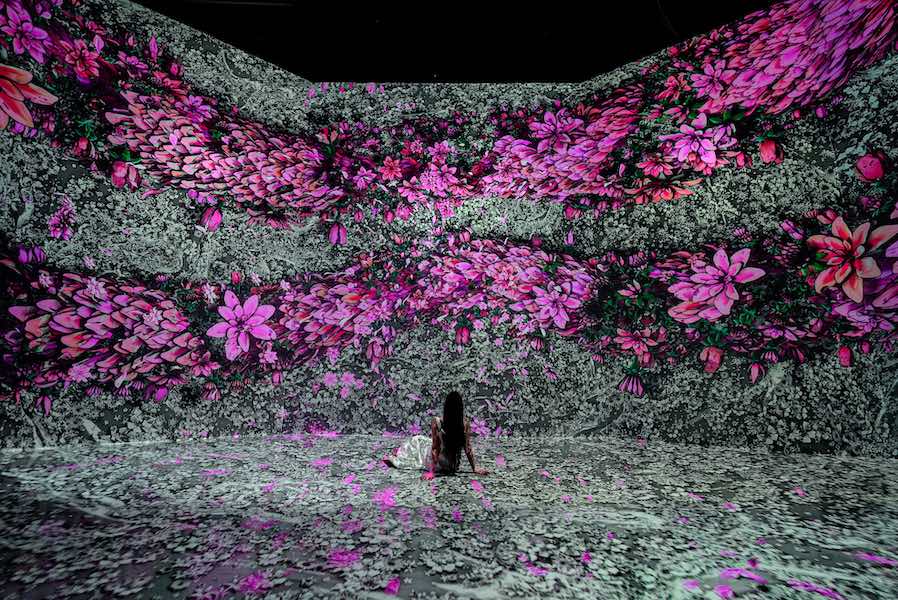As if flying on a drone in pursuit of a flurry of pink petals, one is whorled from world to world, each a spectacularly illustrated field of vision and animated digital display — now an Edenic garden, now a futuristic cityscape, now a medieval village, now a kaleidoscopic tunnel to environs ever beyond. Propelled through portal after portal, one becomes weightless, placeless, subsumed in unfolding scenic wonders on crisscrossing currents of momentum and aurally absorbed in a sound zone of symphonic electronica.

Something like that (individual impressions may vary) is what’s now on offer in an exhibit called ISEKI: Blooming Parallel Worlds through June 2 at Artechouse, a showplace of technology-driven experiential art in Southwest DC. Inspired by the National Cherry Blossom Festival (peak bloom dates this year: March 23–26), the Artechouse Studio artistic team has created an exuberant visual narrative that borrows from the fantasy genres of anime and manga and makes maximum use of a ceiling full of jumbo projectors. As one stands on the balcony by the bar overlooking a vast two-story space, the floor and walls of which are flooded with a sensory overload of imagery in motion, it is as if one becomes the central character in one’s own storytelling — like a solo soul in migration.

There are nearly no words. The creators have trusted each visitor to picture their own story. Only briefly do cryptic signs blink on then off: “AWAKE,” “ANALYZING” — the meaning of which may only be that which each viewer makes of it.
And the hyperreal music is glorious. Calmingly meditative chord progressions like deep-tissue massage for the mind.
The where is all. The when is now. There is no why. Simply follow the flowers, the who is you.

Is this theater? I mentally asked that of ISEKAI before I went to Artechouse and while I was there, and now afterward I’m still mulling. ISEKAI (the word in Japanese means “other worlds”) is certainly theater-resonant, theater-adjacent. When one descends the stairs for a walk around in the vibrantly illuminated room, the vertiginous swirling upon the floor can discombobulate one’s sense of balance like a bemusement ride. Many’s the play that seeks to do that too — to engage us in theater of the self transported and transfigured.

But here there is no applause of appreciation. The exquisitely brilliant performers’ work has all been preprogrammed. They’re done and gone. There is no audience cohesion, no shared emotion, no connection to other humans. It’s a solitary trip through a metaverse, following a flow of flowers. It’s virtual reality without the visor.
Yet in an age when computer-generated graphics are so often deployed in cinema to simulate explosions and combat and terror, it is a refreshing respite to experience technology-infused visual art that is suffused with peace and beauty as ISEKAI is.

And at this juncture in the history of theatrical production when advances in AI and projection technology promise new dimensions of sensorial signfying in theatrical performance, the experience now available at Artechouse is a provocative pointer to what could happen next.
All of which is to say that the question is not “Is this theater?” The question to be asked is “Is it theater yet?”
ISEKAI: Blooming Parallel Worlds is open daily until June 2, 2024 (Monday to Thursday noon to 9 pm; Friday to Sunday 10 am to 10 pm), at Artechouse DC, 1238 Maryland Avenue SW, Washington, DC, walking distance from the National Mall, L’Enfant Plaza, and the District Wharf. Tickets ($17–$31 with special pricing for families Monday–Friday) can be booked in advance online.
(Besides the main projection room described above, Artechouse DC has interactive installations and related exhibits in auxiliary galleries off to the sides, and overlooking the main room is an extended reality bar powered by the Artechouse XR App.)




